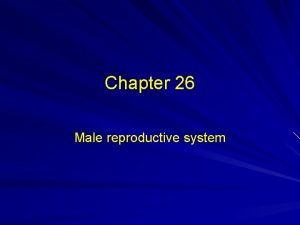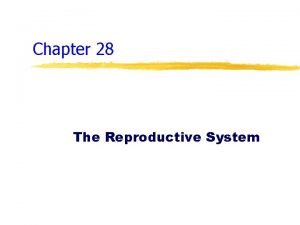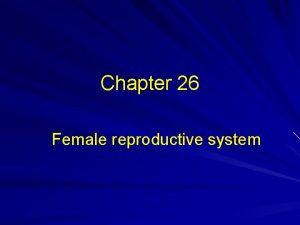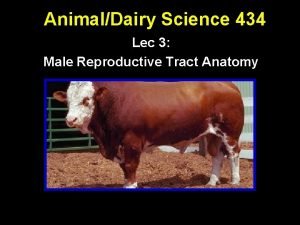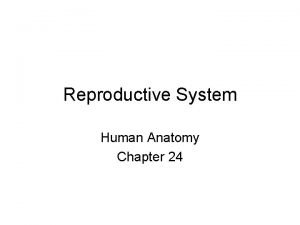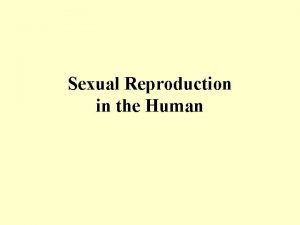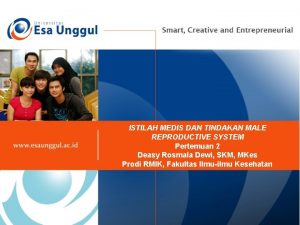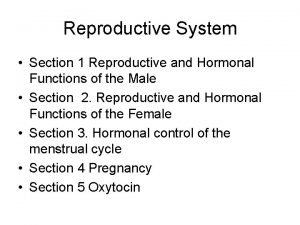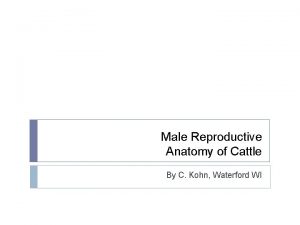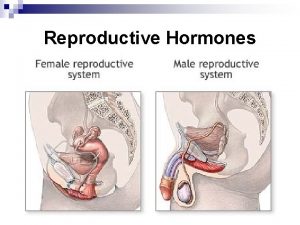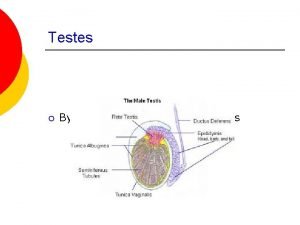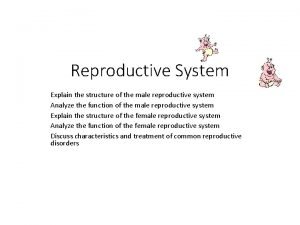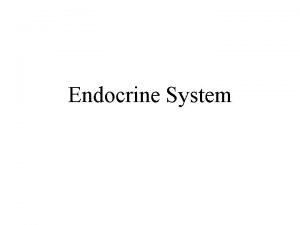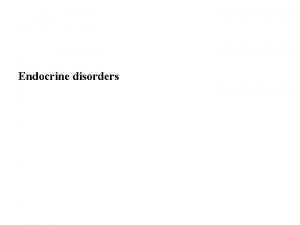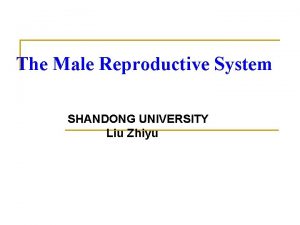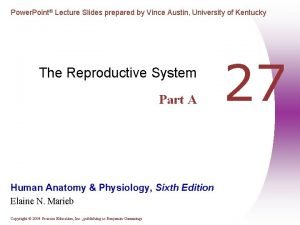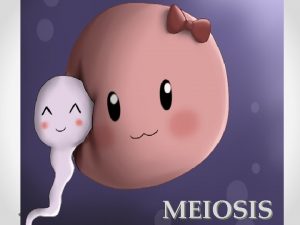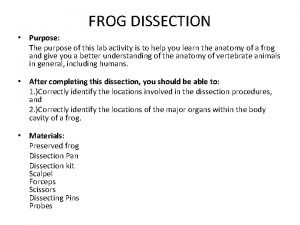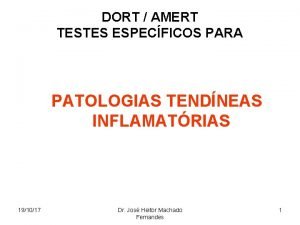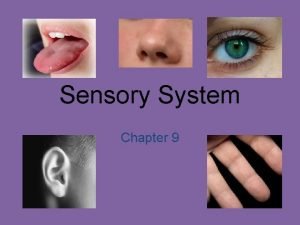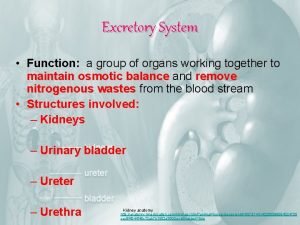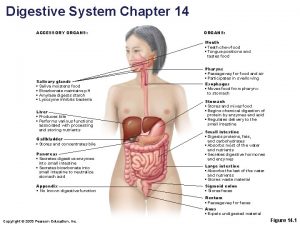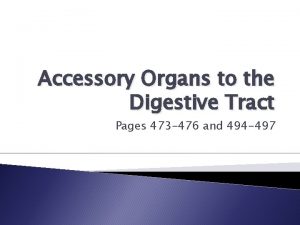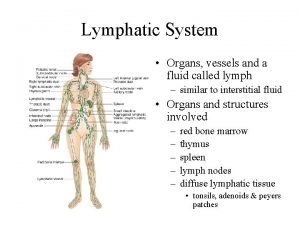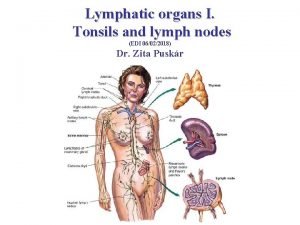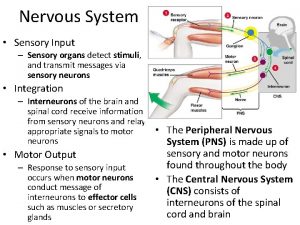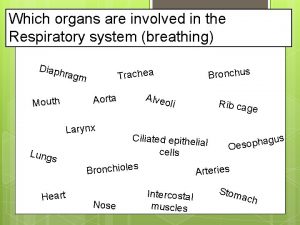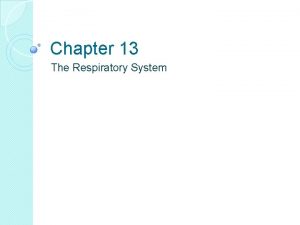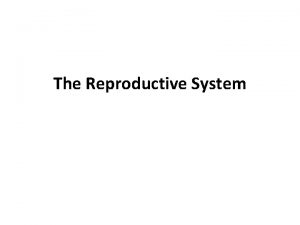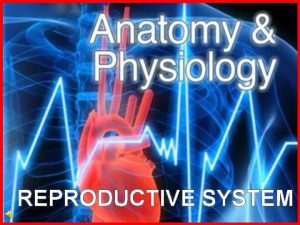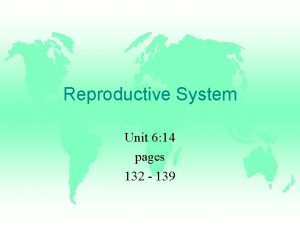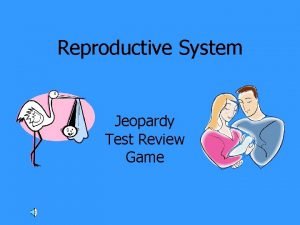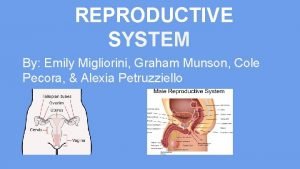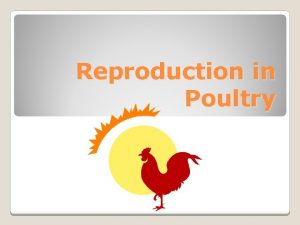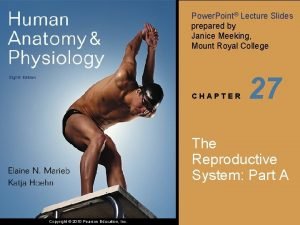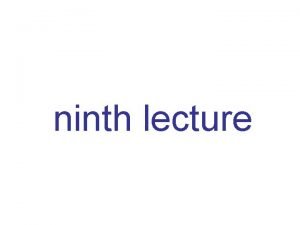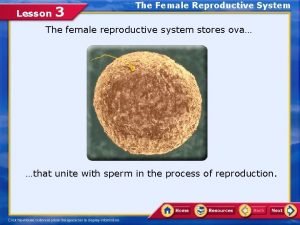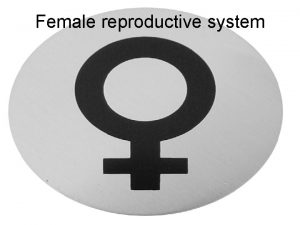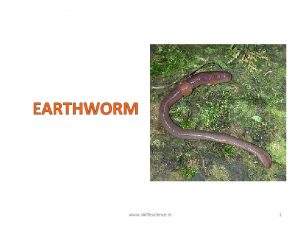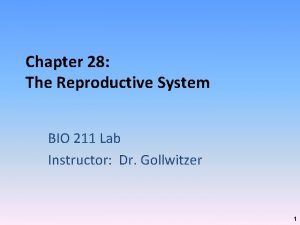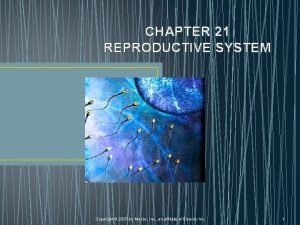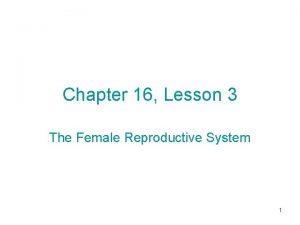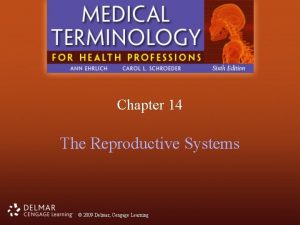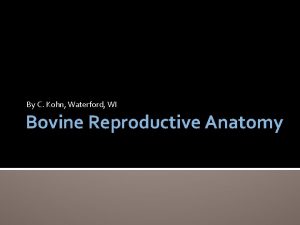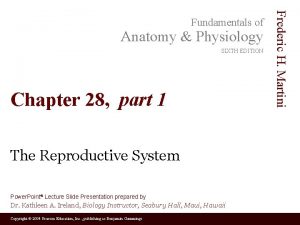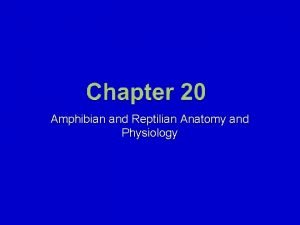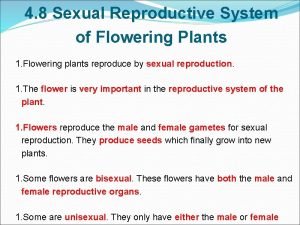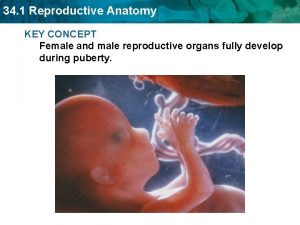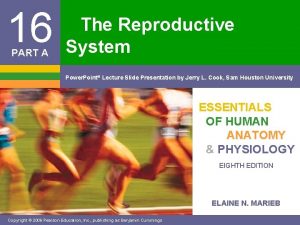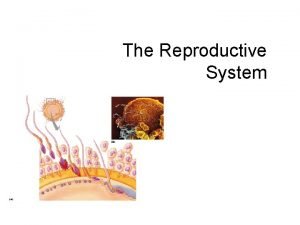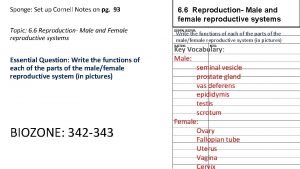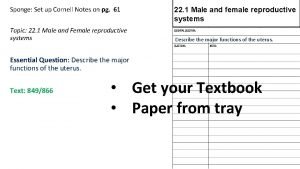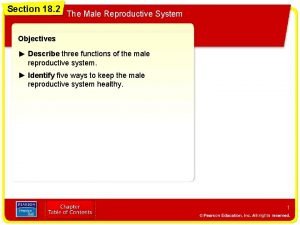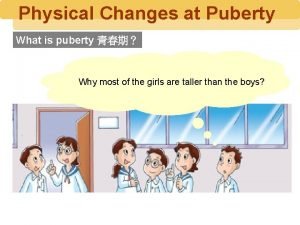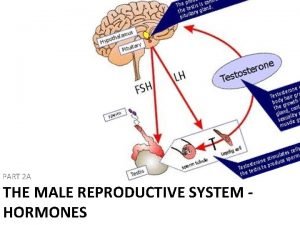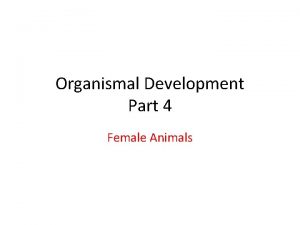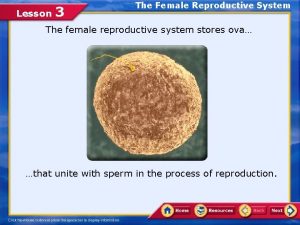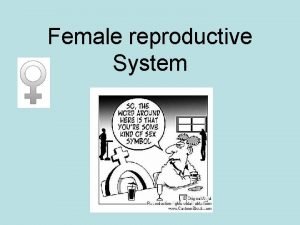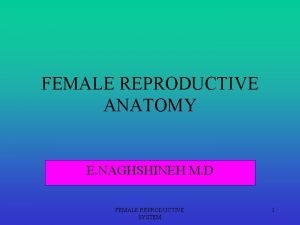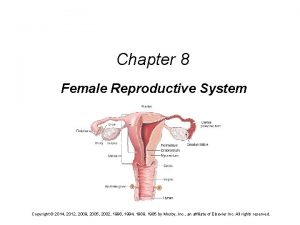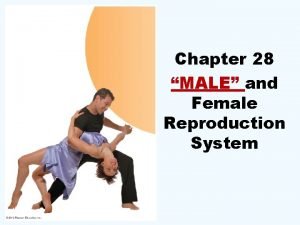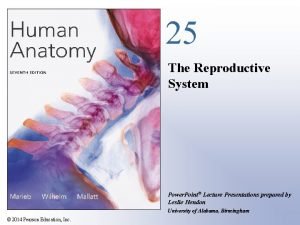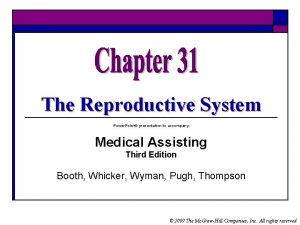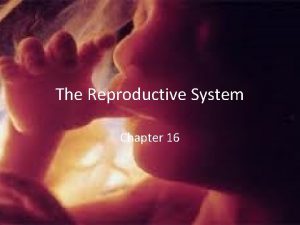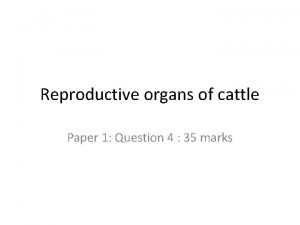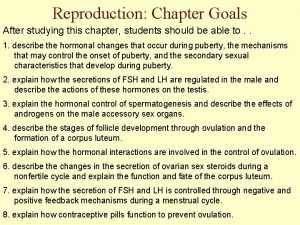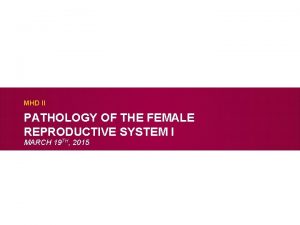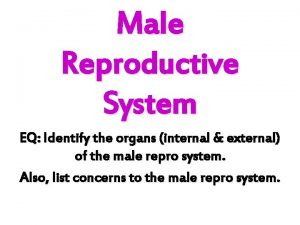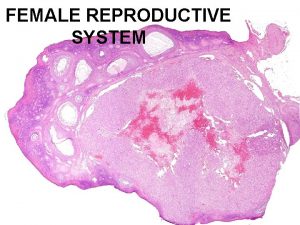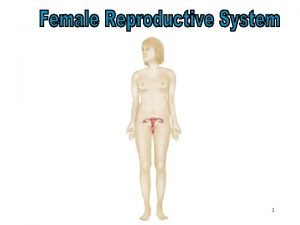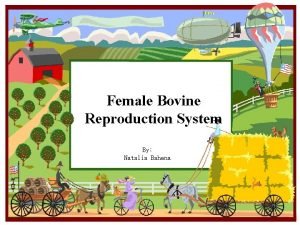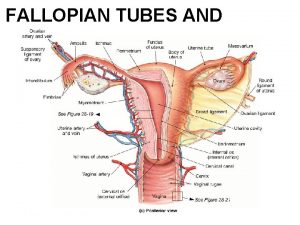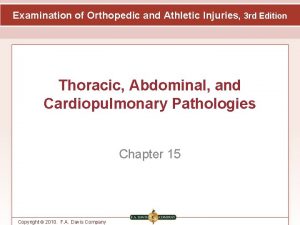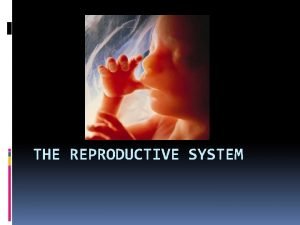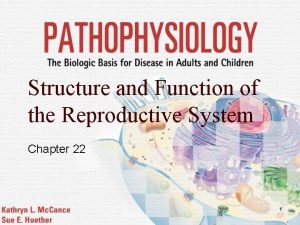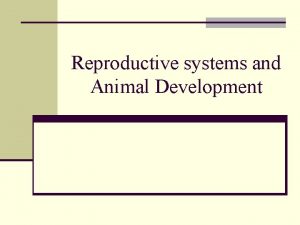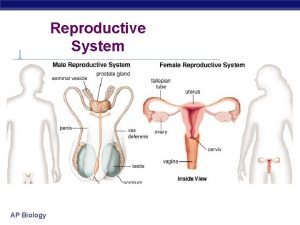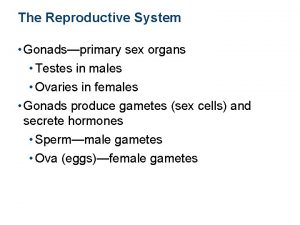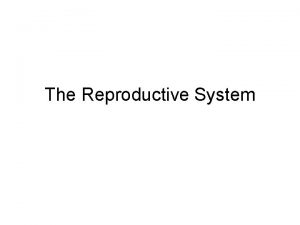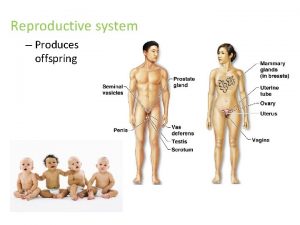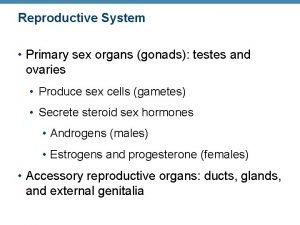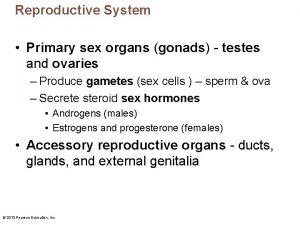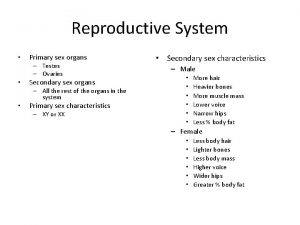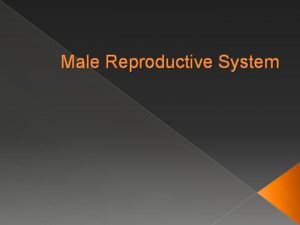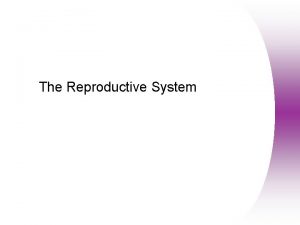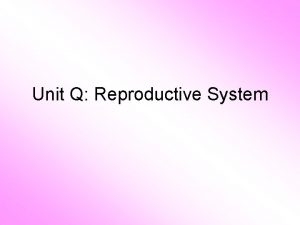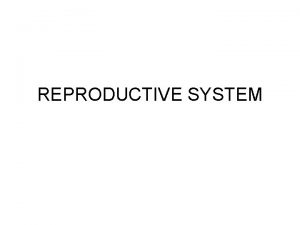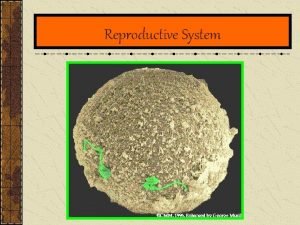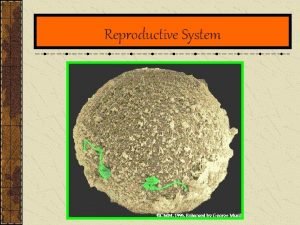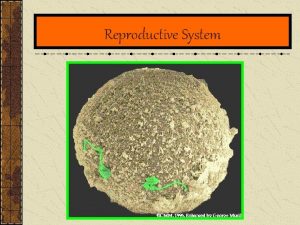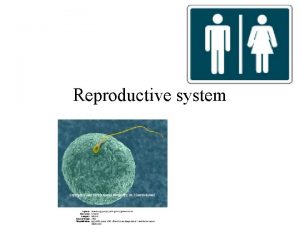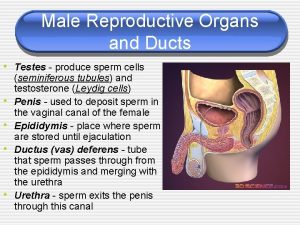The Reproductive System Gonadsprimary sex organs Testes in















































































































































- Slides: 143

The Reproductive System • Gonads—primary sex organs • Testes in males • Ovaries in females • Gonads produce gametes (sex cells) and secrete hormones • Sperm—male gametes • Ova (eggs)—female gametes

Male Reproductive System Overview • Testes • Duct system • Epididymis • Ductus (vas) deferens • Urethra

Male Reproductive System Overview • Accessory organs • Seminal vesicles • Prostate • Bulbourethral glands(Coopers ) • External genitalia • Penis • Scrotum

Ureter Urinary bladder Prostatic urethra Pubis Seminal vesicle Ampulla of ductus deferens Membranous urethra Ejaculatory duct Rectum Prostate Bulbourethral gland Urogenital diaphragm Erectile tissue of the penis Spongy urethra Shaft of the penis Ductus (vas) deferens (a) Epididymis Testis Scrotum Glans penis Prepuce External urethral orifice Figure 16. 2 a

Urinary bladder Prostate Ureter Ampulla of ductus deferens Seminal vesicle Prostatic urethra Orifices of prostatic ducts Membranous urethra Root of penis Ejaculatory duct Bulbourethral gland Ductus deferens Erectile tissue of penis Epididymis Shaft (body) of penis Testis Spongy urethra Glans penis Prepuce (b) External urethral orifice Figure 16. 2 b

Testes • Coverings of the testes • Tunica albuginea—capsule that surrounds each testis • Tunica Vaginalis outside, inbetween there is little fluid, if increased in amount (Hydrocele) • Septa—extensions of the capsule that extend into the testis and divide it into lobules

Spermatic cord Blood vessels and nerves Seminiferous tubule Rete testis Ductus (vas) deferens Epididymis Lobule Septum Tunica albuginea Figure 16. 1

Testes • Each lobule contains one to four seminiferous tubules • Tightly coiled structures • Function as sperm-forming factories • Empty sperm into the rete testis (first part of the duct system) • Sperm travels through the rete testis to the epididymis • Interstitial cells of Lydig , in the seminiferous tubules produce androgens such as testosterone

Spermatic cord Blood vessels and nerves Seminiferous tubule Rete testis Ductus (vas) deferens Epididymis Lobule Septum Tunica albuginea Figure 16. 1

Duct System • Epididymis • Ductus (vas) deferens • Urethra

Epididymis • Comma-shaped, tightly coiled tube • Found on the superior part of the testis and along the posterior lateral side • Functions to mature and store sperm cells (at least 20 days) • Expels sperm with the contraction of muscles in the epididymis walls to the vas deferens • Has head , body &coiled tail.

Spermatic cord Blood vessels and nerves Seminiferous tubule Rete testis Ductus (vas) deferens Epididymis Lobule Septum Tunica albuginea Figure 16. 1

Ductus Deferens (Vas Deferens) • Carries sperm from the epididymis to the ejaculatory duct • Passes through the inguinal canal and over the bladder • Moves sperm by peristalsis • Spermatic cord—ductus deferens, blood vessels, and nerves in a connective tissue sheath

Spermatic cord Blood vessels and nerves Seminiferous tubule Rete testis Ductus (vas) deferens Epididymis Lobule Septum Tunica albuginea Figure 16. 1

Ductus Deferens (Vas Deferens) • Terminates in the ejaculatory duct which unites with the urethra • Expanded end of the ductus deferens is called the ampulla • Ejaculation—smooth muscle in the walls of the ductus deferens create peristaltic waves to squeeze sperm forward • Vasectomy—cutting of the ductus deferens at the level of the testes to prevent transportation of sperm (form of birth control)

Urethra • Extends from the base of the urinary bladder to the tip of the penis • Carries both urine and sperm • Sperm enters from the ejaculatory duct

Urethra • Regions of the urethra • Prostatic urethra—surrounded by prostate • Membranous urethra—travels from prostatic urethra to penis at the level of the pelvic floor muscles • Spongy (penile) urethra—runs the length of the penis

Urinary bladder Prostate Ureter Ampulla of ductus deferens Seminal vesicle Prostatic urethra Orifices of prostatic ducts Membranous urethra Root of penis Ejaculatory duct Bulbourethral gland Ductus deferens Erectile tissue of penis Epididymis Shaft (body) of penis Testis Spongy urethra Glans penis Prepuce (b) External urethral orifice Figure 16. 2 b

Accessory Organs • Seminal vesicles • Prostate • Bulbourethral glands

Urinary bladder Prostate Ureter Ampulla of ductus deferens Seminal vesicle Prostatic urethra Orifices of prostatic ducts Membranous urethra Root of penis Ejaculatory duct Bulbourethral gland Ductus deferens Erectile tissue of penis Epididymis Shaft (body) of penis Testis Spongy urethra Glans penis Prepuce (b) External urethral orifice Figure 16. 2 b

Seminal Vesicles • Located at the base of the bladder • Produces a thick, yellowish secretion (60 percent of semen) • Fructose (sugar) • Vitamin C • Prostaglandins • Other substances that nourish and activate sperm

Urinary bladder Prostate Ureter Ampulla of ductus deferens Seminal vesicle Prostatic urethra Orifices of prostatic ducts Membranous urethra Root of penis Ejaculatory duct Bulbourethral gland Ductus deferens Erectile tissue of penis Epididymis Shaft (body) of penis Testis Spongy urethra Glans penis Prepuce (b) External urethral orifice Figure 16. 2 b

Prostate • Encircles the upper part of the urethra • Secretes a milky fluid(30%) • Helps to activate sperm • Enters the urethra through several small ducts • Prostatitis–inflammation of the prostate • Prostate cancer–third most common cancer in males, commenly prediposed by senile enlargment of prostate

Ureter Urinary bladder Prostatic urethra Pubis Seminal vesicle Ampulla of ductus deferens Membranous urethra Ejaculatory duct Rectum Prostate Bulbourethral gland Urogenital diaphragm Erectile tissue of the penis Spongy urethra Shaft of the penis Ductus (vas) deferens (a) Epididymis Testis Scrotum Glans penis Prepuce External urethral orifice Figure 16. 2 a

Bulbourethral Glands, Cooper's. • Pea-sized gland inferior to the prostate • Produces a thick, clear mucus(5%) • Cleanses the urethra of acidic urine prior to ejaculation • Serves as a lubricant during sexual intercourse • Secreted into the penile urethra

Ureter Urinary bladder Prostatic urethra Pubis Seminal vesicle Ampulla of ductus deferens Membranous urethra Ejaculatory duct Rectum Prostate Bulbourethral gland Urogenital diaphragm Erectile tissue of the penis Spongy urethra Shaft of the penis Ductus (vas) deferens (a) Epididymis Testis Scrotum Glans penis Prepuce External urethral orifice Figure 16. 2 a

Semen • Mixture of sperm and accessory gland secretions • Advantages of accessory gland secretions • Fructose provides energy for sperm cells • Alkalinity of semen helps neutralize the acidic environment of vagina • Semen inhibits bacterial multiplication • Elements of semen enhance sperm motility

External Genitalia • Scrotum • Penis

Ureter Urinary bladder Prostatic urethra Pubis Seminal vesicle Ampulla of ductus deferens Membranous urethra Ejaculatory duct Rectum Prostate Bulbourethral gland Urogenital diaphragm Erectile tissue of the penis Spongy urethra Shaft of the penis Ductus (vas) deferens (a) Epididymis Testis Scrotum Glans penis Prepuce External urethral orifice Figure 16. 2 a

External Genitalia • Scrotum • Divided sac of skin outside the abdomen • Maintains testes at 3°C lower than normal body temperature to protect sperm viability • Outside the capsules covering testes

External Genitalia • Penis • Delivers sperm into the female reproductive tract • Regions of the penis • Shaft • Glans penis (enlarged tip) • Prepuce (foreskin) • Folded cuff of skin around proximal end, with sebeous gland • Often removed by circumcision

Ureter Urinary bladder Prostatic urethra Pubis Seminal vesicle Ampulla of ductus deferens Membranous urethra Ejaculatory duct Rectum Prostate Bulbourethral gland Urogenital diaphragm Erectile tissue of the penis Spongy urethra Shaft of the penis Ductus (vas) deferens (a) Epididymis Testis Scrotum Glans penis Prepuce External urethral orifice Figure 16. 2 a

External Genitalia • Internally there are three areas of spongy erectile tissue around the urethra, 2 corpora cavernosa, above, & corpus spongiosum, under neeth, urethra runs inside it • Erections occur when this erectile tissue fills with blood during sexual excitement preventing venous return

Spermatic cord Blood vessels and nerves Seminiferous tubule Rete testis Ductus (vas) deferens Epididymis Lobule Septum Tunica albuginea Figure 16. 1

Spermatogenesis • Production of sperm cells • Begins at puberty and continues throughout life • Occurs in the seminiferous tubules

Seminiferous Basement membrane tubule Spermatogonium (stem cell) Mitosis Enters prophase of meiosis I Meiosis I completed Meiosis II Secondary spermatocytes Early spermatids Spermiogenesis Spermatogenesis Meiosis Growth Daughter cell type A (remains at basement membrane as a stem cell) Daughter cell type B (moves toward tubule lumen) Primary spermatocyte Late spermatids Sperm Lumen of seminiferous tubule Figure 16. 3

Seminiferous tubule Basement membrane Spermatogonium (stem cell) Mitosis Daughter cell type A (remains at basement membrane as a stem cell) Growth Meiosis Enters prophase of meiosis I Meiosis I completed Daughter cell type B (moves toward tubule lumen) Primary spermatocyte Secondary spermatocytes Meiosis II Early spermatids Figure 16. 3 (1 of 2)

Spermiogenesis Late spermatids Sperm Lumen of seminiferous tubule Figure 16. 3 (2 of 2)

Spermatogenesis • Spermatogonia (stem cells) undergo rapid mitosis to produce more stem cells before puberty • Follicle-stimulating hormone (FSH) modifies spermatogonia division, with production of 1 ry spermatocyte

Spermatogenesis • Primary spermatocytes undergo meiosis • One primary spermatocyte produces four spermatids • Spermatids— 23 chromosomes (half the number of chromosomes)

Human Life Cycle • Union of a sperm (23 chromosomes) with an egg (23 chromosomes) creates a zygote

Figure 16. 4

Spermiogenesis • Late spermatids(mature sperms) are produced with distinct regions • Head • Mid piece • Tail • Sperm cells result after maturing of spermatids • Spermatogenesis (entire process, including spermatogenesis) takes 64 to 72 days

Plasma membrane Tail Axial filament of tail Neck Midpiece Distal centriole Mitochondria Head Acrosome Nucleus Proximal centriole (b) Figure 16. 5 b

Figure 16. 5 a

Anatomy of a Mature Sperm Cell • The only human flagellated cell • Head • Contains DNA • Acrosome—“helmet” on the nucleus, similar to a large lysosome • Breaks down and releases enzymes to help the sperm penetrate an egg • Midpiece • Wrapped by mitochondria for ATP generation

Testosterone Production • The most important hormone of the testes • Produced in interstitial cells of Lydig. • During puberty, luteinizing hormone (LH) activate the interstitial cells • In turn, testosterone is produced

Testosterone Production • Functions of testosterone • Stimulates reproductive organ development • Underlies sex drive • Causes secondary sex characteristics • Deepening of voice • Increased hair growth • Enlargement of skeletal muscles • Thickening of bones

Hypothalamus 1 Gn. RH 2 Gn. RH stimulates the anterior pituitary to release gonadotropins—FSH and LH. Anterior pituitary 3 FSH stimulates spermatogenic cells to produce sperm. 5 2 FSH LH 3 4 Testosterone 5 1 The hypothalamus releases gonadotropin-releasing hormone (Gn. RH). 4 LH stimulates the interstitial cells to release testosterone, which serves as the final trigger for spermatogenesis. Testosterone then enhances spermatogenesis. 5 Rising level of testosterone exerts feedback inhibition on the hypothalamus and pituitary. Testosterone Primary and secondary sex characteristics Seminiferous tubule in testis Supporting cell FSH and testosterone stimulate sperm production Spermatogenic cells Spermatogenesis KEY: Stimulates Inhibits Figure 16. 6

Hypothalamus 1 Gn. RH 1 The hypothalamus releases gonadotropin-releasing hormone (Gn. RH). Anterior pituitary Supporting cell Spermatogenic cells Seminiferous tubule in testis Spermatogenesis KEY: Stimulates Inhibits Figure 16. 6, step 1

Hypothalamus 1 Gn. RH Anterior pituitary 1 The hypothalamus releases gonadotropin-releasing hormone (Gn. RH). 2 Gn. RH stimulates the anterior pituitary to release gonadotropins—FSH and LH. 2 FSH Supporting cell Spermatogenic cells LH Seminiferous tubule in testis Spermatogenesis KEY: Stimulates Inhibits Figure 16. 6, step 2

Hypothalamus 1 Gn. RH Anterior pituitary 1 The hypothalamus releases gonadotropin-releasing hormone (Gn. RH). 2 Gn. RH stimulates the anterior pituitary to release gonadotropins—FSH and LH. 3 FSH stimulates spermatogenic cells to produce sperm. 2 FSH LH 3 Supporting cell Spermatogenic cells Seminiferous tubule in testis Spermatogenesis KEY: Stimulates Inhibits Figure 16. 6, step 3

Hypothalamus 1 Gn. RH Anterior pituitary 1 The hypothalamus releases gonadotropin-releasing hormone (Gn. RH). 2 Gn. RH stimulates the anterior pituitary to release gonadotropins—FSH and LH. 3 FSH stimulates spermatogenic cells to produce sperm. 2 FSH LH 3 4 Testosterone Supporting cell Spermatogenic cells 4 LH stimulates the interstitial cells to release testosterone, which serves as the final trigger for spermatogenesis. Testosterone then enhances spermatogenesis. Primary and secondary sex characteristics Seminiferous tubule in testis Spermatogenesis KEY: Stimulates Inhibits Figure 16. 6, step 4

Hypothalamus 1 Gn. RH 2 Gn. RH stimulates the anterior pituitary to release gonadotropins—FSH and LH. Anterior pituitary 3 FSH stimulates spermatogenic cells to produce sperm. 5 2 FSH LH 3 4 Testosterone 5 1 The hypothalamus releases gonadotropin-releasing hormone (Gn. RH). 4 LH stimulates the interstitial cells to release testosterone, which serves as the final trigger for spermatogenesis. Testosterone then enhances spermatogenesis. 5 Rising level of testosterone exerts feedback inhibition on the hypothalamus and pituitary. Testosterone Primary and secondary sex characteristics Seminiferous tubule in testis Supporting cell FSH and testosterone stimulate sperm production Spermatogenic cells Spermatogenesis KEY: Stimulates Inhibits Figure 16. 6, step 5

Female Reproductive System • Ovaries • Duct System • Uterine tubes (fallopian tubes) • Uterus • Vagina • External genitalia

Suspensory ligament of ovary (part of broad ligament) Infundibulum Uterosacral ligament Rectum Cervix Vagina Anus Greater vestibular gland Uterine tube Ovary Fimbriae Uterus (fundus) Round ligament Urinary bladder Pubic symphysis Mons pubis Urethra Clitoris Hymen Labium minus Labium majus (a) Figure 16. 8 a

Ovaries • Composed of ovarian follicles (sac-like structures) • Each follicle consists of • Oocyte (immature egg) • Follicular cells—surround the oocyte

Growing follicles Primary follicle Degenerating corpus luteum Blood vessels Antrum Corona radiata Mature vesicular (Graafian) follicle Corpus luteum Developing Ruptured Ovulation corpus luteum follicle Germinal epithelium Secondary oocyte Figure 16. 7

Ovarian Follicle Stages • Primary follicle—contains an immature oocyte • Graafian (vesicular) follicle—growing follicle with a maturing oocyte(secondary) • Ovulation—when the egg is mature, the follicle ruptures; occurs about every 28 days • The ruptured follicle is transformed into a corpus luteum

Support for Ovaries • Suspensory ligaments—secure ovary to lateral walls of the pelvis • Ovarian ligaments—attach to uterus • Broad ligament—a fold of the peritoneum, encloses suspensory ligament with other sturctures

Suspensory ligament of ovary Uterine (fallopian) tube Ovarian blood vessels Broad ligament Fundus of uterus Ovary Lumen (cavity) of uterus Infundibulum Fimbriae Ovarian ligament Body of uterus Ureter Uterine blood vessels Uterosacral ligament Cervix Uterine tube Round ligament of uterus Endometrium Myometrium Wall of uterus Perimetrium Cervical canal Vagina (b) Figure 16. 8 b

Duct System • Uterine tubes (fallopian tubes) • Uterus • Vagina

Uterine (Fallopian) Tubes • Receive the ovulated oocyte • Provide a site for fertilization • Attach to the uterus • Little or no contact between ovaries and uterine tubes • Supported and enclosed by the broad ligament

Uterine Tube Anatomy and Physiology • Fimbriae • Finger-like projections at the distal end of the uterine tube • Receive the oocyte from the ovary • Cilia • Located inside the uterine tube • Slowly move the oocyte towards the uterus (takes 3 to 4 days) • Fertilization occurs inside the uterine tube since oocyte lives about 24 hours

Suspensory ligament of ovary Uterine (fallopian) tube Ovarian blood vessels Broad ligament Fundus of uterus Ovary Lumen (cavity) of uterus Infundibulum Fimbriae Ovarian ligament Body of uterus Ureter Uterine blood vessels Uterosacral ligament Cervix Uterine tube Round ligament of uterus Endometrium Myometrium Wall of uterus Perimetrium Cervical canal Vagina (b) Figure 16. 8 b

Uterus • Located between the urinary bladder and rectum • Hollow organ • Functions of the uterus • Receives a fertilized egg • Retains the fertilized egg • Nourishes the fertilized egg

Support for the Uterus • Broad ligament—attached to the pelvis, contains: ovary with its ligaments , uterine artery & round lig. Of the uterus • Round ligament—anchored anteriorly • Uterosacral ligaments—anchored posteriorly

Suspensory ligament of ovary Uterine (fallopian) tube Ovarian blood vessels Broad ligament Fundus of uterus Ovary Lumen (cavity) of uterus Infundibulum Fimbriae Ovarian ligament Body of uterus Ureter Uterine blood vessels Uterosacral ligament Cervix Uterine tube Round ligament of uterus Endometrium Myometrium Wall of uterus Perimetrium Cervical canal Vagina (b) Figure 16. 8 b

Regions of the Uterus • Body—main portion • Fundus—superior rounded region above where uterine tube enters • Cervix—narrow outlet that protrudes into the vagina, has, endo cervix, cervical canal ecto cervix, can only be dilated under general anesthesia

Walls of the Uterus • Endometrium • Inner layer • Allows for implantation of a fertilized egg • Sloughs off if no pregnancy occurs (menses) • Myometrium—middle layer of smooth muscle, where fibroids can grow. • Perimetrium (visceral peritoneum)—outermost serous layer of the uterus

Suspensory ligament of ovary Uterine (fallopian) tube Ovarian blood vessels Broad ligament Fundus of uterus Ovary Lumen (cavity) of uterus Infundibulum Fimbriae Ovarian ligament Body of uterus Ureter Uterine blood vessels Uterosacral ligament Cervix Uterine tube Round ligament of uterus Endometrium Myometrium Wall of uterus Perimetrium Cervical canal Vagina (b) Figure 16. 8 b

Vagina • Extends from cervix to exterior of body • Located between bladder and rectum • Serves as the birth canal • Receives the penis during sexual intercourse • Hymen—partially closes the vagina until it is ruptured during first penetration

Suspensory ligament of ovary Uterine (fallopian) tube Ovarian blood vessels Broad ligament Fundus of uterus Ovary Lumen (cavity) of uterus Infundibulum Fimbriae Ovarian ligament Body of uterus Ureter Uterine blood vessels Uterosacral ligament Cervix Uterine tube Round ligament of uterus Endometrium Myometrium Wall of uterus Perimetrium Cervical canal Vagina (b) Figure 16. 8 b

External Genitalia (Vulva) • Mons pubis • Labia • Clitoris • Urethral orifice • Vaginal orifice • Greater vestibular glands

Mons pubis Labia majora Prepuce of clitoris Clitoris Vestibule Urethral orifice Vaginal orifice Orifice of greater vestibular gland Labia minora Perineum Anus Figure 16. 9

Mons Pubis • Fatty area overlying the pubic symphysis • Covered with pubic hair after puberty, larger surface area than in male

Mons pubis Labia majora Prepuce of clitoris Clitoris Vestibule Urethral orifice Vaginal orifice Orifice of greater vestibular gland Labia minora Perineum Anus Figure 16. 9

Labia • Labia—skin folds • Labia majora • Hair-covered skin fold, resembles scrotum in male • Enclose the labia minora • Also encloses the vestibule • Labia minora—delicate, hair-free folds of skin, as mucous memberane

Mons pubis Labia majora Prepuce of clitoris Clitoris Vestibule Urethral orifice Vaginal orifice Orifice of greater vestibular gland Labia minora Perineum Anus Figure 16. 9

Vestibule and Greater Vestibular Glands • Vestibule • Enclosed by labia majora • Contains external openings of the urethra and vagina • Greater vestibular glands, Bartholine • One is found on each side of the vagina • Secretes lubricant during intercourse, Bartholine abscess, a common disease with painful intercourse

Mons pubis Labia majora Prepuce of clitoris Clitoris Vestibule Urethral orifice Vaginal orifice Orifice of greater vestibular gland Labia minora Perineum Anus Figure 16. 9

Clitoris • Contains erectile tissue • Corresponds to the male penis • The clitoris is similar to the penis in that it is • Hooded by a prepuce • Composed of sensitive erectile tissue • Becomes swollen with blood during sexual excitement • Responsible for excitement during intercourse

Mons pubis Labia majora Prepuce of clitoris Clitoris Vestibule Urethral orifice Vaginal orifice Orifice of greater vestibular gland Labia minora Perineum Anus Figure 16. 9

Perineum • Diamond-shaped region between the anterior ends of the labial folds, anus posteriorly, and ischial tuberosities laterally • Contains pelvic floor muscles

Mons pubis Labia majora Prepuce of clitoris Clitoris Vestibule Urethral orifice Vaginal orifice Orifice of greater vestibular gland Labia minora Perineum Anus Figure 16. 9

Oogenesis and the Ovarian Cycle • The total supply of eggs are present at birth • Ability to release eggs begins at puberty • Reproductive ability ends at menopause • Oocytes are matured in developing ovarian follicles

Oogenesis and the Ovarian Cycle • Oogonia—female stem cells found in a developing fetus • Oogonia undergo mitosis to produce primary oocytes • Primary oocytes are surrounded by cells that form primary follicles in the ovary • Oogonia no longer exist by the time of birth

Oogenesis and the Ovarian Cycle • Primary oocytes are inactive until puberty • Follicle stimulating hormone (FSH) causes some primary follicles to mature each month • Cyclic monthly changes constitute the ovarian cycle

Oogenesis and the Ovarian Cycle • Meiosis starts inside maturing follicle • Produces a secondary oocyte (mature egg) • Follicle development(ovulation) takes about 14 days, under the effect of FSH , to be graffian follicle( that will secrete estrogen), with the release of the secondary oocyte, leaving the corpus luteum, that will secrete Progesteron under the effect of LH. • Secondary oocyte is released and surrounded by a corona radiata

Oocyte Figure 16. 11

Oogenesis and the Ovarian Cycle • Meiosis is completed after ovulation only if sperm penetrates • Ovum is produced • Once ovum is formed, the 23 chromosomes can be combined with those of the sperm to form the fertilized egg (zygote) • If the secondary oocyte is not penetrated by a sperm, it dies and does not complete meiosis to form zygote.

Male and Female Differences • Meiosis • Males—produces four functional sperm • Females—produces one functional ovum • Sex cell size and structure • Sperm are tiny, motile, and equipped with nutrients in seminal fluid • Egg is large, non-motile, and has nutrient reserves to nourish the embryo until implantation

Follicle Development in Ovary Meiotic Events Before birth Oogonium (stem cell) 2 n Follicle cells Oocyte Mitosis Primary oocyte 2 n Primary follicle Growth Primary oocyte (arrested in prophase I; present at birth) 2 n Primary follicle (ovary inactive) Childhood Monthly from puberty to menopause Primary follicle Primary oocyte (still arrested in prophase I) 2 n Meiosis I (completed by one primary oocyte each month) Secondary oocyte (arrested in metaphase II) n First polar body Growing follicle Mature vesicular (Graafian) follicle Ovulation Sperm Meiosis II of polar body (may or may not occur) Polar bodies (all polar bodies degenerate) n n Second polar body Meiosis II completed (only if sperm penetration occurs) Ovulated secondary oocyte Ovum Figure 16. 10

Uterine (Menstrual) Cycle • Cyclic changes of the endometrium • Regulated by cyclic production of estrogens and progesterone • FSH and LH regulate the production of estrogens and progesterone • Both menstrual and ovarian cycles are about 28 days in length • Ovulation typically occurs about midway through cycle on day 14

Uterine (Menstrual) Cycle • Stages of the menstrual cycle • Menstrual phase • Proliferative stage • Secretory stage

Uterine (Menstrual) Cycle • Menstrual phase • Days 1 to 5 • Functional layer of the endometrium is sloughed • Bleeding occurs for 3 to 5 days • By day 5, growing ovarian follicles are producing more estrogen

Uterine (Menstrual) Cycle • Proliferative stage • Days 6 to 14 • Regeneration of functional layer of the endometrium • Estrogen levels rise • Ovulation occurs in the ovary at the end of this stage • Safe period

Uterine (Menstrual) Cycle • Secretory stage • Days 15 to 28 • Levels of progesterone rise and increase the blood supply to the endometrium • Endometrium increases in size and readies for implantation

Uterine (Menstrual) Cycle • Secretory stage (continued) • If fertilization does occur • Embryo produces a hormone that causes the corpus luteum to continue producing its hormones • If fertilization does NOT occur • Corpus luteum degenerates as LH blood levels decline

Plasma hormone level LH (a) Fluctuation of gonadotropin levels: Fluctuating levels of pituitary gonadotropins (FSH and LH) in the blood regulate the events of the ovarian cycle. FSH Figure 16. 12 a

(b) Ovarian cycle: Structural changes in the ovarian follicles during the ovarian cycle are correlated with (d) changes in the endometrium of the uterus during the uterine cycle. Primary Secondary Vesicular Ovulation follicle Follicular phase Ovulation (Day 14) Corpus luteum Degenerating corpus luteum Luteal phase Figure 16. 12 b

Plasma hormone level Estrogens Progesterone (c) Fluctuation of ovarian hormone levels: Fluctuating levels of ovarian hormones (estrogens and progesterone) cause the endometrial changes of the uterine cycle. The high estrogen levels are also responsible for the LH/FSH surge in (a). Figure 16. 12 c

Basal layer Functional layer Blood vessels Endometrial glands Menstrual flow 1 5 Menstrual phase 10 Proliferative phase 15 20 25 Secretory phase (d) The three phases of the uterine cycle: • Menstrual: Shedding of the functional layer of the endometrium. • Proliferative: Rebuilding of the functional layer of the endometrium. • Secretory: Begins immediately after ovulation. Enrichment of the blood supply and glandular secretion of nutrients prepare the endometrium to receive an embryo. 28 Days The menstrual and proliferative phases occur before ovulation, and together correspond to the follicular phase of the ovarian cycle. The secretory phase corresponds in time to the luteal phase of the ovarian cycle. Figure 16. 12 d

Hormone Production by the Ovaries • Estrogens • Produced by follicle cells • Cause secondary sex characteristics • Enlargement of accessory organs of the female reproductive system • Development of breasts • Appearance of axillary and pubic hair • Increase in fat beneath the skin, particularly in hips and breasts • Widening and lightening of the pelvis • Onset of menses (menstrual cycle)

Hormone Production by the Ovaries • Progesterone • Produced by the corpus luteum • Production continues until LH diminishes in the blood • Does not contribute to the appearance of secondary sex characteristics • Other major effects • Helps maintain pregnancy • Prepare the breasts for milk production

Growing follicles Primary follicle Degenerating corpus luteum Blood vessels Antrum Corona radiata Mature vesicular (Graafian) follicle Corpus luteum Developing Ruptured Ovulation corpus luteum follicle Germinal epithelium Secondary oocyte Figure 16. 7

Mammary Glands • Present in both sexes, but only function in females • Modified sweat glands • Function is to produce milk • Stimulated by sex hormones (mostly estrogens) to increase in size

Anatomy of Mammary Glands • Areola—central pigmented area • Nipple—protruding central area of areola • Lobes—internal structures that radiate around nipple • Lobules—located within each lobe and contain clusters of alveolar glands • Alveolar glands—produce milk when a woman is lactating (producing milk) • Lactiferous ducts—connect alveolar glands to nipple

Skin (cut) Pectoralis major muscle Connective tissue suspensory ligament Adipose tissue Lobe Areola Nipple Opening of lactiferous duct Lactiferous sinus Lactiferous duct Lobule containing alveoli (a) Figure 16. 13 a

First rib Skin (cut) Pectoralis major muscle Connective tissue suspensory ligament Adipose tissue Lobe Areola Nipple Opening of lactiferous duct Lactiferous sinus Lactiferous duct Lobule containing alveoli Hypodermis (superficial fascia) Intercostal muscles (b) Figure 16. 13 b

Mammography • X-ray examination that detects breast cancers too small to feel • Recommended every 2 years for women between 40 and 49 years old and yearly thereafter

Malignancy (a) Mammogram procedure (b) Film of normal breast (c) Film of breast with tumor Figure 16. 14 a-c

Functions of the Placenta • Forms a barrier between mother and embryo (blood is not exchanged) • Delivers nutrients and oxygen • Removes waste from embryonic blood • Becomes an endocrine organ (produces hormones) and takes over for the corpus luteum (by end of second month) by producing • Estrogen • Progesterone • Chorionicgonadotrophic. +ve pregnancy test

Effects of Pregnancy on the Mother • Pregnancy—period from conception until birth • Anatomical changes • Enlargement of the uterus • Accentuated lumbar curvature (lordosis) • Relaxation of the pelvic ligaments and pubic symphysis due to production of relaxin

Figure 16. 20 a-d

Effects of Pregnancy on the Mother • Physiological changes • Gastrointestinal system • Morning sickness is common due to elevated progesterone and estrogens • Heartburn is common because of organ crowding by the fetus • Constipation is caused by declining motility of the digestive tract

Effects of Pregnancy on the Mother • Physiological changes (continued) • Urinary system • Kidneys have additional burden and produce more urine • The uterus compresses the bladder, causing stress incontinence

Effects of Pregnancy on the Mother • Physiological changes (continued) • Respiratory system • Nasal mucosa becomes congested and swollen • Vital capacity and respiratory rate increase • Dyspnea (difficult breathing) occurs during later stages of pregnancy

Effects of Pregnancy on the Mother • Physiological changes (continued) • Cardiovascular system • Blood volume increases by 25 to 40 percent • Blood pressure and pulse increase • Varicose veins are common

Childbirth (Parturition) • Labor—the series of events that expel the infant from the uterus • Rhythmic, expulsive contractions • Operates by the positive feedback mechanism • False labor—Braxton Hicks contractions are weak, irregular uterine contractions

4 Hypothalamus sends efferent impulses to posterior pituitary, where oxytocin is stored 5 Posterior pituitary releases oxytocin to blood; oxytocin targets mother’s uterine muscle 6 Uterus responds by contracting more vigorously 1 Baby moves deeper into mother’s birth canal 3 Afferent impulses to hypothalamus 2 Pressoreceptors in cervix of uterus excited Positive feedback mechanism continues to cycle until interrupted by birth of baby Figure 16. 21

1 Baby moves deeper into mother’s birth canal Positive feedback mechanism continues to cycle until interrupted by birth of baby Figure 16. 21, step 1

1 Baby moves deeper into mother’s birth canal 2 Pressoreceptors in cervix of uterus excited Positive feedback mechanism continues to cycle until interrupted by birth of baby Figure 16. 21, step 2

1 Baby moves deeper into mother’s birth canal 3 Afferent impulses to hypothalamus 2 Pressoreceptors in cervix of uterus excited Positive feedback mechanism continues to cycle until interrupted by birth of baby Figure 16. 21, step 3

4 Hypothalamus sends efferent impulses to posterior pituitary, where oxytocin is stored 1 Baby moves deeper into mother’s birth canal 3 Afferent impulses to hypothalamus 2 Pressoreceptors in cervix of uterus excited Positive feedback mechanism continues to cycle until interrupted by birth of baby Figure 16. 21, step 4

4 Hypothalamus sends efferent impulses to posterior pituitary, where oxytocin is stored 5 Posterior pituitary releases oxytocin to blood; oxytocin targets mother’s uterine muscle 1 Baby moves deeper into mother’s birth canal 3 Afferent impulses to hypothalamus 2 Pressoreceptors in cervix of uterus excited Positive feedback mechanism continues to cycle until interrupted by birth of baby Figure 16. 21, step 5

4 Hypothalamus sends efferent impulses to posterior pituitary, where oxytocin is stored 5 Posterior pituitary releases oxytocin to blood; oxytocin targets mother’s uterine muscle 6 Uterus responds by contracting more vigorously 1 Baby moves deeper into mother’s birth canal 3 Afferent impulses to hypothalamus 2 Pressoreceptors in cervix of uterus excited Positive feedback mechanism continues to cycle until interrupted by birth of baby Figure 16. 21, step 6

Stages of Labor • Dilation • Cervix becomes dilated • Full dilation is 10 cm • Uterine contractions begin and increase • Cervix softens and effaces (thins) • The amnion ruptures (“breaking the water”) • Longest stage at 6 to 12 hours

Placenta Umbilical cord Uterus Cervix Vagina Sacrum (a) Dilation (of cervix) Figure 16. 22 a

Stages of Labor • Expulsion • Infant passes through the cervix and vagina • Can last as long as 2 hours, but typically is 50 minutes in the first birth and 20 minutes in subsequent births • Normal delivery is head first (vertex position) • Breech presentation is buttocks-first

Perineum (b) Expulsion (delivery of infant) Figure 16. 22 b

Stages of Labor • Placental stage • Delivery of the placenta • Usually accomplished within 15 minutes after birth of infant • Afterbirth—placenta and attached fetal membranes • All placental fragments should be removed to avoid postpartum bleeding

Uterus Placenta (detaching) Umbilical cord (c) Placental (delivery of the placenta) Figure 16. 22 c

Developmental Aspects of the Reproductive System • Males • Enlargement of testes and scrotum signals onset of puberty (often around age 13) • Females • Budding breasts signal puberty (often around age 11) • Menarche—first menstrual period

Developmental Aspects of the Reproductive System • Menopause—a whole year has passed without menstruation • Ovaries stop functioning as endocrine organs • Childbearing ability ends • There is a no equivalent of menopause in males, but there is a steady decline in testosterone

A Closer Look: Contraception • Contraception—birth control • Birth control pill—most-used contraceptive • Relatively constant supply of ovarian hormones from pill is similar to pregnancy • Ovarian follicles do not mature, ovulation ceases, menstrual flow is reduced

A Closer Look: Contraception • Morning-after pill (MAP) • Taken within 3 days of unprotected intercourse • Disrupts normal hormonal signals to the point that fertilization is prevented • Other hormonal birth control devices cause cervical mucus to thicken • Minepill (tablet) • Norplant (rods placed under the skin)

A Closer Look: Contraception • Intrauterine device (IUD) • Plastic or metal device inserted into uterus • Prevents implantation of fertilized egg • Sterilization • Tubal ligation (females)—cut or cauterize uterine tubes • Vasectomy (males)—cut or cauterize the ductus deferens

A Closer Look: Contraception • Coitus interruptus—withdrawal of penis prior to ejaculation • Rhythm (fertility awareness)—avoid intercourse during period of ovulation or fertility • Record daily basal temperature (body temperature rises after ovulation) • Record changes in pattern of salivary mucus

A Closer Look: Contraception • Barrier methods • Diaphragms • Cervical caps • Condoms • Spermicidal foams • Gels • Sponges

A Closer Look: Contraception • Abortion—termination of pregnancy • Miscarriage—spontaneous abortion is common and frequently occurs before a woman knows she is pregnant • RU 486 or “abortion pill”—induces miscarriage during first 7 weeks of pregnancy


Condom Birth control pills Diaphragm Contraceptive sponge Spermacidal inserts Contraceptive jelly
 Kurt bumby
Kurt bumby Sex snv
Sex snv Sex sex sex
Sex sex sex Sex sex sex
Sex sex sex Secondary sexual characters
Secondary sexual characters Primary sex organ of the male reproductive system? *
Primary sex organ of the male reproductive system? * Posterior view of the female reproductive organs
Posterior view of the female reproductive organs Female reproductive organs sagittal section
Female reproductive organs sagittal section Reproductive organs of the bull
Reproductive organs of the bull Genital development
Genital development Horse reproductive system
Horse reproductive system Oviduct funnel
Oviduct funnel The reproductive system chapter 16
The reproductive system chapter 16 Womens anatomy diagram
Womens anatomy diagram What is gonad
What is gonad Sex
Sex Advanced higher biology unit 2
Advanced higher biology unit 2 Sex determination and sex linkage
Sex determination and sex linkage Once a sex offender always a sex offender
Once a sex offender always a sex offender Duct system female reproductive
Duct system female reproductive Endocrine system and reproductive system
Endocrine system and reproductive system Testes psicométricos
Testes psicométricos Oogenesi
Oogenesi Male and female reproductive system
Male and female reproductive system Testes neuropsicopedagógicos pdf
Testes neuropsicopedagógicos pdf Anaorchidism adalah
Anaorchidism adalah Tindakan menempatkan testes masuk ke skrotum disebut
Tindakan menempatkan testes masuk ke skrotum disebut Testes regressivos
Testes regressivos Function of testes
Function of testes Functions of testes
Functions of testes Tabela tukey
Tabela tukey Male gonad
Male gonad Functions of testis
Functions of testis Testicular function
Testicular function Testes
Testes What hormone does the testes produce
What hormone does the testes produce Cretinism
Cretinism Paula melo silva
Paula melo silva Testes
Testes Pearosn
Pearosn Fish reproductive system
Fish reproductive system History of biopsychology
History of biopsychology Etimiologia
Etimiologia 2n haploid or diploid
2n haploid or diploid Frog internal organs
Frog internal organs Sindrome de intersecção
Sindrome de intersecção Sensory system organs
Sensory system organs Function of the excretory system
Function of the excretory system Function of mouth in digestive system
Function of mouth in digestive system Accessory organs of the digestive system
Accessory organs of the digestive system Major and accessory organs of the digestive system
Major and accessory organs of the digestive system Lymphatic system and urinary system
Lymphatic system and urinary system Formation of lymph
Formation of lymph Tonsils histology
Tonsils histology Function of lymphatic system
Function of lymphatic system Organs of the sensory system
Organs of the sensory system Which organs are involved in respiratory system
Which organs are involved in respiratory system Respiratory system organs
Respiratory system organs Chapter 16
Chapter 16 Function of cervix
Function of cervix Male reproductive system and its function
Male reproductive system and its function Fetus reproductive system
Fetus reproductive system Ovarian ligament.
Ovarian ligament. Anatomy of the reproductive system exercise 42
Anatomy of the reproductive system exercise 42 Femaleanatomy
Femaleanatomy Oogenesis process
Oogenesis process Female reproductive system pregnancy
Female reproductive system pregnancy Unit 6:14 reproductive system
Unit 6:14 reproductive system Round ligament of uterus
Round ligament of uterus Reproductive system jeopardy
Reproductive system jeopardy Parts of male and female reproductive system
Parts of male and female reproductive system What is reproductive system
What is reproductive system Luteinizing hormone in male reproductive system
Luteinizing hormone in male reproductive system Poultry reproductive system
Poultry reproductive system Male reproductive system in plant
Male reproductive system in plant Art-labeling activity: the male reproductive system, part 1
Art-labeling activity: the male reproductive system, part 1 Do chickens have vaginas
Do chickens have vaginas Male reproductive system information
Male reproductive system information Where is semen stored
Where is semen stored What does the seminal vesicle do
What does the seminal vesicle do Lesson 3 the female reproductive system
Lesson 3 the female reproductive system Male reproductive system plants
Male reproductive system plants Function of male reproductive system
Function of male reproductive system Anatomy of fish reproductive system
Anatomy of fish reproductive system Anatomy of ovary slideshare
Anatomy of ovary slideshare Function of the female reproductive system
Function of the female reproductive system In pila fertilization is...
In pila fertilization is... Juxtaposing in earthworm
Juxtaposing in earthworm Male fetal pig reproductive system labeled
Male fetal pig reproductive system labeled Claspers are structures involved in:
Claspers are structures involved in: Male plant reproductive system
Male plant reproductive system How to care reproductive system
How to care reproductive system Figure 28-2 the female reproductive system
Figure 28-2 the female reproductive system Chapter 21 reproductive system
Chapter 21 reproductive system Chapter 20 reproduction and pregnancy
Chapter 20 reproduction and pregnancy Chapter 17 reproductive system diseases and disorders
Chapter 17 reproductive system diseases and disorders Chapter 16 the reproductive system figure 16-2
Chapter 16 the reproductive system figure 16-2 Chapter 16 the reproductive system
Chapter 16 the reproductive system Chapter 14 the reproductive system
Chapter 14 the reproductive system Female cow reproductive system
Female cow reproductive system Figure 28-1 the male reproductive system
Figure 28-1 the male reproductive system Reptilian reproductive system
Reptilian reproductive system Plants reproductive system
Plants reproductive system Colon function in male reproductive system
Colon function in male reproductive system Figure 16-1 male reproductive system
Figure 16-1 male reproductive system Similarities between male and female reproductive system
Similarities between male and female reproductive system Reproductive system objectives
Reproductive system objectives Female reproductive system label
Female reproductive system label Sponge reproductive system
Sponge reproductive system Pathway of sperm in male reproductive system
Pathway of sperm in male reproductive system Male reproductive system
Male reproductive system Oogenesis and follicular development
Oogenesis and follicular development When does puberty end
When does puberty end What are primary sexual characteristics
What are primary sexual characteristics Oogonium
Oogonium Lesson 3 the female reproductive system
Lesson 3 the female reproductive system Color of female reproductive system
Color of female reproductive system Female external genitalia
Female external genitalia Chapter 8 female reproductive system
Chapter 8 female reproductive system Drawing of the male and female reproductive system
Drawing of the male and female reproductive system Toad digestive system
Toad digestive system Conclusion of female reproductive system
Conclusion of female reproductive system Mesosalpinx
Mesosalpinx Boar reproductive system
Boar reproductive system Female reproductive system pathology
Female reproductive system pathology The reproductive system chapter 16
The reproductive system chapter 16 Puberty reproductive system
Puberty reproductive system Cow reproductive anatomy
Cow reproductive anatomy Summary of the reproductive system
Summary of the reproductive system Female reproductive system pathology
Female reproductive system pathology Female reproductive system pathology
Female reproductive system pathology Layers of scrotum anatomy
Layers of scrotum anatomy What is seminal vesicle in male reproductive system
What is seminal vesicle in male reproductive system Female reproductive system
Female reproductive system Abortion types
Abortion types Female reproductive system pathology
Female reproductive system pathology Bovine female reproductive system
Bovine female reproductive system Female reproductive system anatomy
Female reproductive system anatomy Female reproductive system pathology
Female reproductive system pathology What is the joining of egg and sperm called
What is the joining of egg and sperm called Testicular anatomy
Testicular anatomy Reproductive system
Reproductive system Reproductive system
Reproductive system Female reproductive system labeled
Female reproductive system labeled





